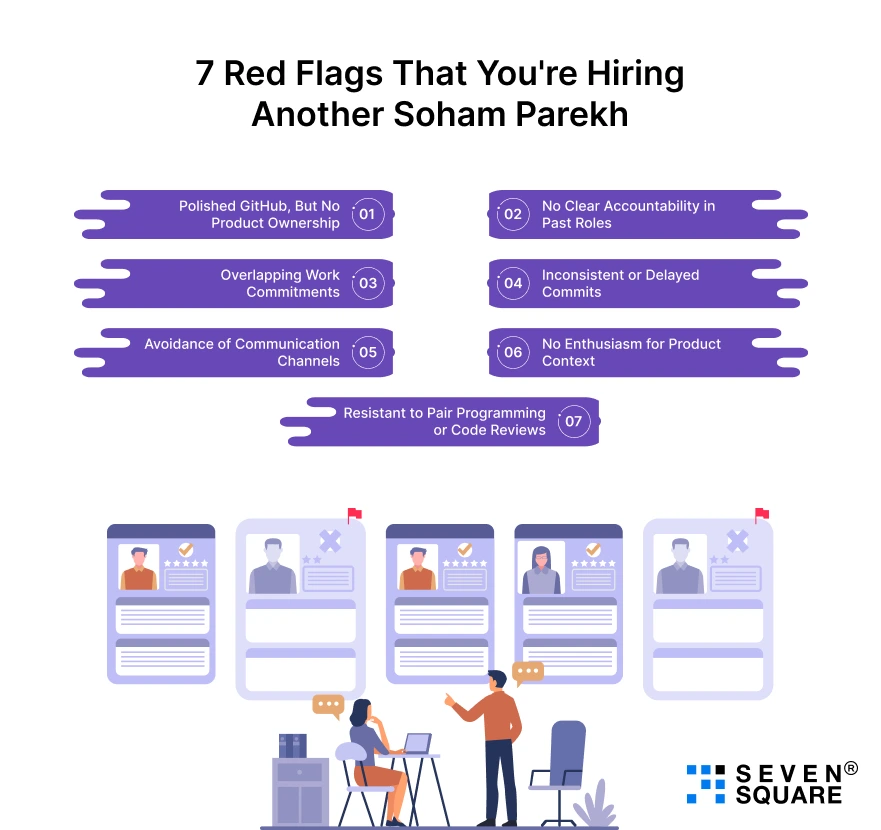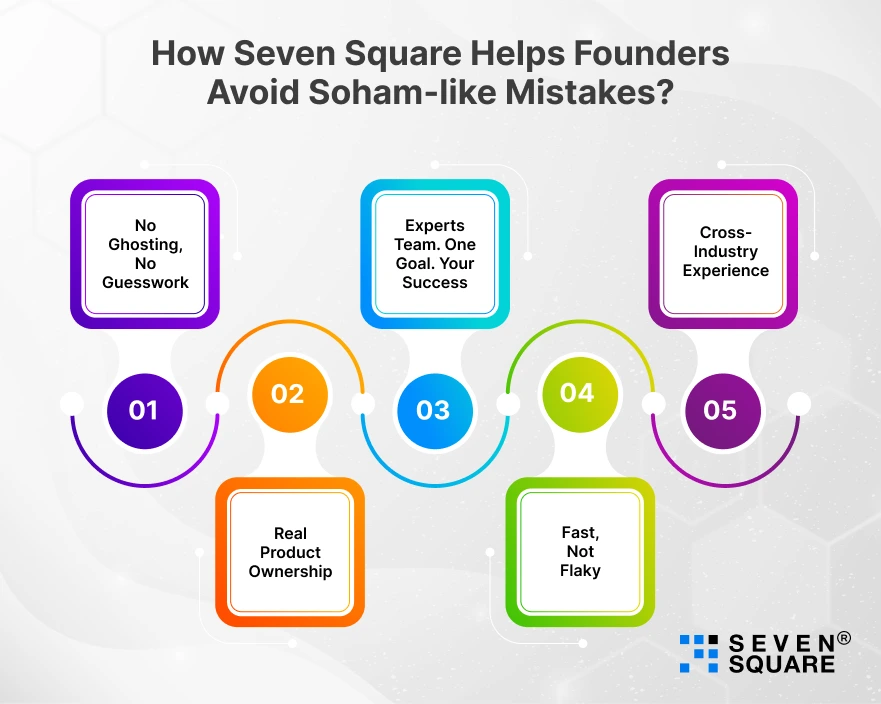You’ve got a product roadmap, investors are circling, and your team’s speed depends on one thing: Hiring the right engineers. So you move fast.
You post on AngelList, maybe go into the YC community, and start shortlisting candidates.
Then comes someone with a perfect resume: Clean GitHub, YC-backed project mentions, & a polite email thread.
You’re thinking: This guy could be our 10x dev.
But months later, things aren’t shipping. Deadlines slip. Commits are erratic.
You’re holding late-night retros, wondering why you’re still debugging features that should’ve been done weeks ago.
Then you find out your engineer, Soham Parekh, isn’t just working for you.
He’s working for everyone.
Are you looking for remote hiring red flags so you don’t hire moonlighting engineer like Soham Parekh?
You are at the right place, here we tried to explain the startup hiring mistakes that you should avoid to scale your business.
Who Is Soham Parekh? The Serial Moonlighter
If you’ve been anywhere near startup Twitter or LinkedIn lately, you’ve heard the name.
He made headlines as a serial moonlighter, an engineer who simultaneously worked at 8 to 10 different startups, often YC-funded or fast-growing.
He passed interviews with flying colors, promised full-time commitment, and then quietly juggled multiple contracts behind the scenes.
This isn’t just one guy gone rogue. It’s a wake-up call for startup founders everywhere.
Hiring Soham Parekh isn’t the problem. Hiring like Soham Parekh is. And that’s where many companies fall into the trap.
Why Does This Happen So Often in Remote Tech Hiring?
When the world went remote, so did hiring. With it came a gold rush of global talent, but also many red flags that are harder to catch.
At Seven Square, we’ve worked with hundreds of companies across industries eCommerce, logistics, fintech, edtech, & we’ve seen this happen time and time again.
Product managers and CTOs make three key mistakes:
- Rushing through hiring without deep vetting.
- Failing to monitor work authenticity post-hire.
- Overlooking signs of moonlighting.
In Soham’s case, he built a reputation based on clean interviews and boilerplate code, not consistent or original delivery.
So, what are the red flags in remote hiring you need to look for?
7 Red Flags That You’re Hiring Another Soham Parekh

Hiring Soham Parekh didn’t start with bad intent; it started with missed red flags.
In remote hiring, especially for tech startups, it’s easy to fall for surface-level indicators like a strong LinkedIn or a sleek GitHub profile.
But as we’ve seen with serial moonlighters like Soham, the truth often lies beneath the surface.
Here are the detailed remote hiring red flags you must watch for to avoid startup hiring mistakes:
1. Polished GitHub, But No Product Ownership
- A common trait of a moonlighting engineer is showcasing flashy but shallow contributions.
- He had public repos filled with code that looked decent, but none tied to real, end-to-end shipped products.
- Ask candidates for detailed walkthroughs of what they built, not just where they pushed code.
2. No Clear Accountability in Past Roles
- When someone hops across many gigs without real ownership, they might be working like Soham did: Everywhere, but committed nowhere.
- Serial moonlighters often freelance their way into a full-time contract, then vanish when it’s time to deliver.
- Look for roles where the developer was responsible for outcomes, not just outputs.
3. Overlapping Work Commitments
- One of the biggest signs of a moonlighting developer in a startup is their hesitance to share availability.
- They dodge standups, are “always busy,” or work odd hours.
- He fooled multiple startups by pretending to be working full-time for each of them, when in fact, he was balancing 10 gigs.
4. Inconsistent or Delayed Commits
- A clear tech hiring cautionary tale: If someone isn’t committing regularly or their commits are erratic, they might not be working at all, or worse, working somewhere else during your hours.
- Use commit logs, pull request timelines, and code reviews to track performance.
5. Avoidance of Communication Channels
- Communication avoidance is another red flag. He would skip daily calls, avoid Slack, and ghost meetings with vague excuses.
- In startup remote hiring, responsiveness and clarity are everything. A strong remote engineer over-communicates, not disappears.
6. No Enthusiasm for Product Context
- A key difference between a good hire and someone like Soham is care.
- He didn’t ask questions about the product, users, or business model; he just wanted a spec and a deadline.
- That’s a sign of someone who’s in it for the paycheck, not the mission.
- This is where moonlighting ethics in remote work become clear. If they don’t care about your success, why should you invest in them?
7. Resistant to Pair Programming or Code Reviews
- They often hesitated or asked to reschedule whenever asked for collaborative sessions.
- This behavior often hides a lack of understanding or, worse, that the person isn’t doing the work themselves.
- If a developer avoids live reviews, consider it a major flag.
These warning signs are also related to the lessons from the hiring Soham Parekh scandal that many startups are now documenting.
Don’t wait to learn from your own mistakes. If you’re unsure, review your current hiring process through the lens of startup remote hiring best practices after Soham Parekh.
From Trap to Trust: How We Vet Talent at Seven Square?
We’ve been building software for a long time.
Over that time, our team has grown to 50+ product-minded engineers, designers, and QA experts who don’t just “code”, we think in creating products.
Here’s how we avoid falling for another Soham:
- Deep technical interviews with product-scenario walkthroughs.
- Code test with originality check (we use tools to detect GitHub/Copilot boilerplate).
- Pair programming trial with our internal team.
- Structured onboarding and ownership alignment.
- Regular async check-ins and outcome-based progress reviews.
A Lesson for Startup Founders & PMs: Think Like a Product, Not Just a Sprint
Hiring isn’t about filling a seat. It’s about building with ownership. Soham Parekh may have known how to code, but he didn’t care about your product. That’s the real trap.
So here’s the lesson: hire people who treat your business like a product, not just a gig.
You need engineers who:
- Ask questions about the user, not just the API.
- Suggest architecture improvements instead of just building what’s asked.
- Communicate blockers early and transparently.
- Care about scalability, testing, and handoff.
That’s what we mean at Seven Square when we say we build with engineering + product thinking.
How Seven Square Helps Founders Avoid Soham-like Mistakes?

You’ve seen what happens when startups get burned by moonlighters like Soham Parekh.
Now, here’s why smart founders, CTOs, and product managers choose Seven Square not just for development, but for reliable, scalable execution:
- No Ghosting, No Guesswork: You get clear communication, sprint-based planning, and full transparency from day one.
- Real Product Ownership: We don’t just write code, we help you shape features with a product mindset.
- Experts Team. One Goal. Your Success: Our team includes senior engineers, QAs, designers, and product thinkers, all match your vision.
- Fast, Not Flaky: We deliver quality software fast without shortcuts. No boilerplate GitHub magic. Just tested, scalable code.
- Cross-Industry Experience: From fintech to healthcare, logistics to eCommerce, we’ve solved hard problems with working solutions.
Tired of Moonlighting Engineers? Contact Us for Dedicated Teams!
Avoid the Soham Trap to Build with Trust, Not Just Talent
Remember, hiring isn’t just about filling a role; it’s about building your future.
The Soham Parekh case showed us how even top startups can make big hiring mistakes, especially with moonlighting engineers who hide behind impressive resumes.
So here’s the simple truth: Don’t just hire a developer. Hire someone who takes ownership, cares about your product, and grows with your team.
At Seven Square, we’ve helped startups across the world fix broken teams, avoid bad hires, and build strong tech with real impact.
Whether you need a full-stack team or help improving your remote hiring process, we’re here to help you spot red flags and hire the right people from day one.
Founders: When you review your next candidate, ask yourself: “Am I hiring a Soham, or someone who’ll scale with us?”
Build smart. Build strong. And always build with people who actually care about your product.
FAQs
- To avoid hiring a moonlighting developer, use remote hiring best practices like in-depth vetting, live coding tests, originality checks, and async communication evaluations.
- At Seven Square, our development team helped startups with an ownership-driven product to scale their businesses.
- Serial moonlighters like Soham Parekh often pass interviews by using pre-built portfolios, clean GitHub profiles, and confident communication.
- They say the right things but don’t back it up with delivery.
- They also depend on the fact that many startups don’t verify remote hires deeply enough, a mistake we help our clients avoid at Seven Square.
- The key lesson is this: don’t hire based on a resume alone.
- Look for an ownership mindset, product delivery experience, and clear communication.
- His story is a warning that even great-looking candidates can become a costly hiring mistake without deeper vetting and structured onboarding.
- Yes, even YC-backed startups have fallen for moonlighting engineers like Soham Parekh.
- It proves that impressive credentials don’t guarantee commitment.
- That’s why smart companies now use reliable hiring partners like Seven Square to reduce risk and scale teams with real contributors.